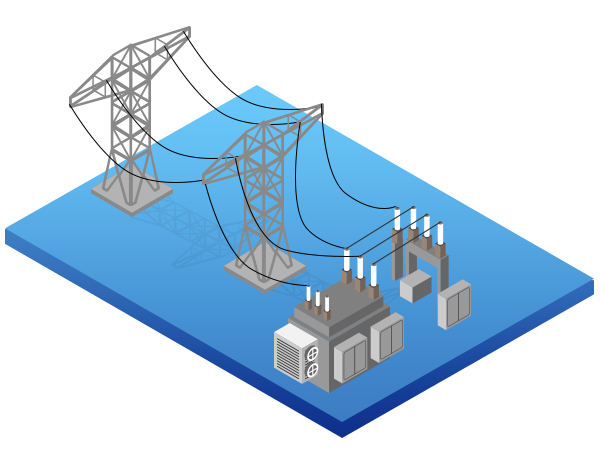Who are the best Pennsylvania electricity and natural gas providers?
These great electricity and natural gas companies in Pennsylvania won a Gold, Silver, or Bronze award in our semi-annual rankings of Pennsylvania energy providers.
Gold Tier Award-Winning Electricity and Natural Gas Companies
Silver Tier Award-Winning Electricity and Natural Gas Companies
Bronze Tier Award-Winning Electricity and Natural Gas Companies
More Electricity Providers in Pennsylvania
What is a Pennsylvania Electricity Company?
There are actually three different kinds of electricity companies in Pennsylvania that work together to supply electricity to your home. Generally, you'll be interacting with an "Electric Generation Supplier" ("EGS" for short), which provides retail electric plans to consumers and handles the billing and customer service aspects of your service. Behind the scenes, the generators and utilities will get the power routed to your home safely and reliably.

Pennsylvania Electricity Generators
Electricity generators build and maintain the power plants that feed power into the Pennsylvania electricity grid, which is then sold to PA electricity suppliers. Because Pennsylvania is part of the PJM grid, electricity can come from as far away as New Jersey or Illinois. While Pennsylvania makes much of its own electricity, it doesn't need to come from here.

Your Local Utility
Your local electric utility maintains the meters, wires, poles, and underground cables that bring the electricity from the generators to your home. Similarly, natural gas utilities that must manage and maintain their pipes. Utilities are also responsible for reading your meter and providing that information to your Electric Generation Supplier (EGS).

Electric Generation Supplier (EGS)
These are the electricity suppliers that purchase electricity on the wholesale market from the generators and sell that supply to you. They make sure you are properly billed for the amount of electricity you use. They provide customer service, billing, and payment functions to you, the consumer. They also create different brands, plans, and products to meet your unique lifestyle needs as a customer.
PJM and Pennsylvania Public Utility Commission
The PJM Interconnection is the government-regulated entity responsible for managing the Pennsylvania electricity grid. They forecast electricity needs across the Mid-Atlantic Region, as well as Ohio and northern Illinois. They then coordinate with generators to make sure there is steady, sufficient power to keep everyone's lights on.
The Pennsylvania Public Utility Commission (PUC) regulates providers of all kinds of utility services in Pennsylvania and enforces consumer protection laws. Pennsylvania law requires Pennsylvania electric and natural gas utilities to offer default supply service that you can select if you don't want to shop for a retail supplier. For that reason, PUC must also oversee the "Price to Compare" (PTC) default rates offered by Pennsylvania electricity and natural gas utilities.
What is a Pennsylvania Natural Gas Company?
There are actually four different kinds of natural gas companies in Pennsylvania that work together to deliver natural gas safely to your home. A Natural Gas Supplier (NGS) supplies retail natural gas plans to consumers and handles the billing and customer service aspects of your service. Behind the scenes, natural gas producers, pipeline companies, and the local utilities make sure gas gets to your home safely and reliably.

Pennsylvania Natural Gas Sources
Pennsylvania produces much of its own natural gas. Natural gas producers sell their gas either directly to natural gas supply companies or on the wholesale market. While most of the state's natural gas comes from north and western parts of the state, some is brought up via pipelines from gas wells as far south as Texas and Lousiana. The cost of moving gas through pipelines to your local gas utility is added to the price of the gas.

Local Distribution Companies (LDCs)
These are regulated utility companies that are responsible for storing and distributing natural gas to customers in Pennsylvania. The LDCs maintain the natural gas supply infrastructure in their service areas. This includes both large pipelines and the local distribution network.

Natural Gas Suppliers
These are companies that offer natural gas plans and pricing options to customers in Pennsylvania. Customers can choose to purchase natural gas from one of these suppliers rather than their local distribution company.
Office of Consumer Advocate (OCA)
The OCA is an independent state agency that represents the interests of electricity and natural gas customers in Pennsylvania. The OCA provides information and assistance to customers, and advocates for consumer protections in Pennsylvania's electricity and natural gas markets.
Pennsylvania Electricity and Natural Gas Utilities
These companies are primarily responsible for safely and reliably delivering electricity or natural gas to your home. Electric utilities must maintain their poles and wires while natural gas utilities look after their network of pipes and valves.
Pennsylvania Electric Company FAQs
-
Can you choose your own energy supplier company in Pennsylvania?
- Instead of being forced to buy electricity directly from the local electric utility, PA Power Switch provides Pennsylvania consumers the opportunity to select their own electrical supplier. In Pennsylvania, price reductions, the development of new electric programs, and enhancements to customer service can all result from competition among energy suppliers.
-
When can you switch electricity suppliers in Pennsylvania without penalty?
- Providers must send two notices to their customers before their contract ends. The first one is between 45 and 90 days before the expiration date. The second is sent 30 to 45 days. Usually, if the switch is made no sooner than 14 days before the contract expiration date specified in the notice, the residential customer will not be charged an early termination fee. However, if the customer does not respond to a renewal notice, some providers will roll them automatically into a variable plan which usually has a higher rate.
-
Can you switch your Pennsylvania electricity supplier at any time?
- You can change your energy supplier whenever you choose. However, many fixed-rate plans will charge you an "Early Termination Fee" or ETF if you decide to leave a plan before the end of the agreed-upon contract period.
-
How late can your Pennsylvania electric bill be before they shut it off?
- In most cases in Pennsylvania, your monthly bill usually comes from your utility. This means you are subject to the utility's policies for late payments. Customers have 20 days to pay the bill after its mailing date. Bill payments made after the due date will be charged a late fee not more than 1.5 percent per month.
When a customer fails to pay their bill, the utility can shut off the power. The utility must first send a written notice 10 days prior to the scheduled shutoff date. The utility will have up to 60 days to shut off service. This gives the customer time to work out a payment arrangement with the utility. At least three days before the service shut off, the utility company must attempt to contact the customer in person or by telephone. During the winter months (December 1 through March 31), the utility cannot shut off service without PA PUC’s approval. -
How do electric companies work in Pennsylvania?
- Generators produce electricity and sell it to Electric Generation Suppliers (EGS), who in turn sell it to their customers. The electricity is delivered through the Pennsylvania power grid to customers by their utility. The local utility maintains and fixes the power lines that connect to local homes and businesses. The utility also sends your monthly bill. This bill contains both your energy supply charges from your EGS and the distribution charges from your utility.
-
How does my local utility charge me?
- In Pennsylvania, there are 8 electric utilities. Each manages and maintains the powerlines that deliver electricity to homes and businesses in its service area. While consumers are free to choose their own EGS, Pennsylvania law requires these local utilities to also provide default electricity supply to those customers who choose not to shop for a retail supplier. This also protects customers from service disruptions if a supplier leaves the state.
In Pennsylvania, the default rate is called the Price to Compare. Basically, it's the sum of the electricity supply cost plus the transmission costs for sending bulk power to the utility's switching yards. Because Pennsylvania utilities are prohibited from making money on the default rate, Price to Compare customers are charged what their utility pays for the electricity. -
How much is an electric deposit in Pennsylvania?
- Pennsylvania utilities may not charge a deposit that is more than 2 months of estimated usage. Payments can be divided into 3 monthly payments.
-
Who are the best electricity providers in Pennsylvania?
The highest-rated electricity companies are Constellation, Frontier Utilities, Energy Harbor, American Power & Gas, Direct Energy, and CleanSky Energy.
These are Pennsylvania Energy Ratings' Gold Tier Providers. This distinction is only given to energy retailers who offer the best rates with superlative customer service with a wide range of electricity plans to choose from. Customers can rest assured when choosing these providers to be serviced by the most capable and industrious retailers in the Pennsylvania electric market!
-
Who are the lowest-cost electricity providers in Pennsylvania?
The Pennsylvania electric companies with the cheapest rates are American Power & Gas with 2 plans starting at 12.2¢/kWh, Public Power with 5 plans starting at 12.3¢/kWh, Verde Energy with 1 plan starting at 12.6¢/kWh, and APG&E with 6 plans starting at 12.7¢/kWh.
Here is Pennsylvania Energy Ratings' full portfolio of over 90+ electric providers to choose from!-
What are the cheapest electricity plans in Pennsylvania?
The plans with the lowest rates this week are Residential Clean Energy Plan from American Power & Gas starting at 8.7¢/kWh, Electric 12 Month Fixed Rate WITH MRC from Public Power starting at 10.1¢/kWh, Renewable Freedom Plan from Indra Energy starting at 10.1¢/kWh, and True Classic 6 from APG&E starting at 11.3¢/kWh.
Here are other 90+ electricity companies with affordable plans!-
Who are the best natural gas providers in Pennsylvania?
The highest-rated natural gas companies are Constellation, Frontier Utilities, Energy Harbor, American Power & Gas, Direct Energy, and CleanSky Energy.
These are Pennsylvania Energy Ratings' Gold Tier Providers. This distinction is only given to energy retailers who offer the best rates with superlative customer service with a wide range of natural gas plans to choose from. Customers can rest assured when choosing these providers to be serviced by the most capable and industrious retailers in the Pennsylvania gas market!
-
Who are the lowest-cost natural gas providers in Pennsylvania?
The Pennsylvania gas companies with the cheapest rates are XOOM Energy with 3 plans starting at $0.606ccf, Santanna Energy Services with 1 plan starting at $0.617ccf, Direct Energy with 2 plans starting at $0.709ccf, and Major Energy with 2 plans starting at $0.709ccf.
Here is Pennsylvania Energy Ratings' full portfolio of over 90+ gas providers to choose from!-
What are the cheapest natural gas plans in Pennsylvania?
The plans with the lowest rates this week are Renewable Freedom Plan from Indra Energy starting at $0.517ccf, Residential Clean Gas Plan from American Power & Gas starting at $0.525ccf, Flex Gas Choice Plan from NRG Home starting at $0.539ccf, and SureLock 12 from XOOM Energy starting at $0.589ccf.
Here are other 90+ natural gas companies with affordable plans!
Other Providers
We have not vetted and do not sell plans for these electricity and natural gas companies in Pennsylvania. However, they may still serve customers in Pennsylvania and are included for historical and educational purposes.
How to Compare Pennsylvania Electricity and Natural Gas Suppliers?
Each energy provider in Pennsylvania tries to offer something unique to their customers. They could offer special products for your home that improve your energy efficiency. Or they might just try to get you a low rate with no frills! (Hey, who doesn't like a good deal!). When you compare these plans and products, think about what kinds of things are important to you - then we can help you find the right company and product for your situation.
Common Pennsylvania Electricity Plans and Prices
Most Pennsylvania retail energy companies offer the most popular kind of plan - a fixed rate 12 month plan. The 'fixed rate' means that the amount the energy provider charges you for each kilowatt-hour or ccf you use will be quite stable from month to month. The '12 month plan' means that they guarantee you that rate for 12 months, and in exchange, you promise to buy electricity or natural gas from them for the next 12 months.
There are other types of plans available as well, such as shorter 6-month fixed rate plans, month-to-month plans with variable rates, or even plans that can last for 2 years or more.
How Pennsylvania Energy Ratings Rates Companies?
We use our decades of combined experience in the Pennsylvania energy market to evaluate Pennsylvania energy providers on a variety of factors. We review customer service, plan selection, deposit policies, customer service quality, customer reviews, and other indicators to determine how a given electric provider stacks up against the competition.
After we compile the data, we boil it down to a few key areas, and give each area a score between 1 and 5, with 5 being best. Then we collate the scores and award a Gold, Silver or Bronze ranking for those providers.































































